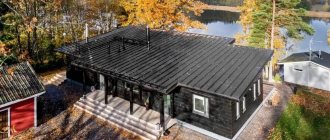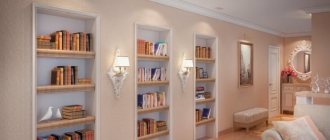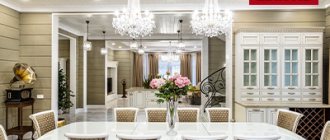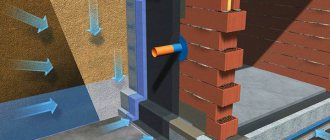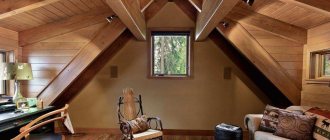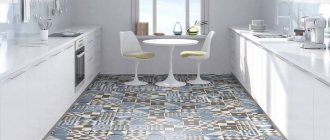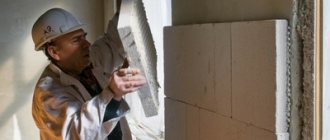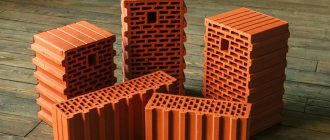Real estate
00:00, 02.12.2020 12 Plot: House in focus
Advantages and disadvantages of the four most popular materials
Photo: Irina Plotnikova
The variety of modern construction technologies can cause panic in the future homeowner: the choice is large, some types of materials are close to each other in cost, but they all have different features. In this article we do not set out to understand all the nuances of materials science, but a start will be made. Today we will outline the main range of questions that you need to ask yourself when choosing a wall material, and we will list the main features of some of the technologies that are the most popular in our latitudes. And in subsequent articles we will analyze each technology in more detail.
Video description
For more information on comparing different technologies, watch the following video:
Table 1. Volume of repair work after 30 years Source bako.ru
Table 2. Comparison of the durability of buildings depending on the main building material Source bako.ru
Now let’s move on to describing the features of each type of building material separately.
No. 4. Minimalism
Minimalism is one of the most popular modern styles for private homes . As in the interior, minimalism involves the use of only necessary and functionally significant details, so buildings are characterized by strict forms and an almost complete absence of decor . Other features include:
- conciseness, adherence to the rules of composition, simplicity, use of only the most necessary, versatility of each element, rigor and geometricity of forms;
- preference is given to natural materials, incl. stone, wood and glass;
- no hints of pretentiousness or complex finishing elements;
- uniform color scheme, mostly light shades;
- built-in lighting around the perimeter of the house and the presence of large windows, floor-to-ceiling glazing in the living room.
Minimalism in architecture is reduced to a minimum of details, a maximum of light and space.
Construction of a house for permanent residence made of brick
Buildings made of brick are the most massive structures. They perfectly resist the effects of all kinds of natural factors and, at the same time, have an attractive appearance. However, in order to build your own house from the most popular material at first glance - brick, you will have to incur significant financial costs. But the durability of such a house will be significantly higher. If a good-quality frame house “lives” for about 60-70 years, then a house made of good brick will last more than 100 years. However, it is important to note that brick also comes in different qualities. Therefore, if you decide to build with brick, take special time to study the characteristics of the material in order to wisely choose a quality one. Pay special attention to the frost resistance of the brick - how many cycles can it withstand (30, 50, 100?).
Building a brick house Source sk-mera.ru
The main advantages of a brick house are the high strength of the material. And in terms of its load-bearing capacity characteristics, a wall erected from this type of building materials is almost as good as concrete. Such characteristics are ideal for both low-rise suburban construction and the construction of multi-storey buildings. In addition, a house made of brick will not burn, rot or shrink.
Only, in terms of energy efficiency, walls made of ceramic or sand-lime bricks lag significantly behind other building materials. In order to ensure sufficient energy efficiency for a private home, a brick wall must have a minimum thickness of 120 cm. It becomes clear that no one will build a “bunker” with such walls for permanent year-round living, so today brick is increasingly used as a facing material.
Another important disadvantage of building a house made of bricks is the high cost of the material, so it is important to correctly calculate your financial capabilities, otherwise construction may take a very long time.
Summarizing all of the above, we can say that the main advantages of brick as a building material are:
- the possibility of long-term operation of the built house;
- high frost resistance;
- precise geometry of products;
- good combination with any type of masonry mortar;
- high strength;
- aesthetic appearance.
However, brick has many disadvantages :
- Low moisture resistance of some types of material. For example, sand-lime brick strongly absorbs water; this can be clearly seen when it takes on a dark tint during rain. This quality greatly affects the humidity indoors. In this regard, sand-lime brick is not used for laying basements and basements; sand-lime brick should not be used when building a house in regions with high air humidity. To prevent moisture from accumulating in a brick house, you need to properly prepare the walls. And these are additional costs that are often overlooked.
- High thermal conductivity. To achieve positive characteristics, it is necessary to resort to additional costs for thermal insulation of walls or thickening them.
- High product weight. The brick has a large mass, which makes the structure heavier and creates an even greater load on the foundation. To solve this problem, it is necessary to build a stronger and more solid foundation, and this further increases construction costs.
- High cost of material. It is certainly more expensive than materials for frame construction. In addition, one should not lose sight of the cost of transportation costs, which amount to around 4% of the cost of the property. These are direct costs such as fuel, depreciation, oil, drivers and so on.
So, it turns out that brick, despite its tangible advantages, has significant disadvantages, so before making it the main material in the construction of a private house, you should clearly define your financial priorities, since your choice will depend on them.
See also: Catalog of house projects presented at the Low-Rise Country house exhibition.
Beautiful house made of timber Source comfortoria.ru
Ceramic block - durable and modern material
In Europe, when deciding what material to build a house from, they often choose ceramic block. It is environmentally friendly (consists of a baked mixture of clay with wood sawdust), and it can be built cheaply and quickly. A house like this will last for at least 150 years, and it can be made multi-story (the safety margin allows this). The surface of the ceramic block is corrugated on the sides, and there are pores inside. The individual elements are joined using a tongue-and-groove connection.
Ceramic blocks of various sizes.
Dimensions and characteristics of ceramic blocks
The sizes of ceramic blocks vary, but their height is standard, equal to brickwork. This is convenient - you can build according to the design of a brick house. A block measuring 50 x 24.8 x 23.8 cm weighs 25 kg, and the volume is equal to 15 bricks of 3.3 kg each. It’s easier and faster to lay one such slab, and you’ll need less mortar. The width of the blocks is 23, 24 and 25 cm. Their length (which determines the thickness of our walls) can be from 25 to 51 cm. A tongue-and-groove lock is located on this side.
To lay a load-bearing wall, blocks with a length of 30 cm are taken. And if you make walls 38 cm thick or more, you won’t even have to insulate them. After all, porous blocks have low thermal conductivity - from 0.14 to 0.29 watts per square meter per degree Celsius. Thicker blocks (38, 44 and 50 cm long) are marked as M100. If thin but reliable walls are planned, then you can take M150 brand blocks. The ceramic block can withstand up to 50 freezing and defrosting cycles. This matches the F50 brand.
Advantages and disadvantages of ceramic blocks
| Advantages of ceramic blocks + | Disadvantages of ceramic blocks - |
| Low weight coupled with high strength allows the construction of even multi-story buildings. And quickly and without unnecessary labor costs. | High price - this material for the walls of the house belongs to the elite group. |
| The mortar is used more economically than for brickwork - there is no need to use it in vertical joints. | It is difficult to find a good craftsman to build walls, since the material is quite new. |
| Frost resistance at a high level. | Ceramic blocks are very fragile, so they must be transported and stored very carefully. |
| The material can withstand fire for at least 4 hours. | |
| Thanks to its porosity, the ceramic block perfectly absorbs noise and also retains heat. | |
| The walls of these blocks “breathe”, regulating humidity and creating an excellent microclimate. | |
| Such a house can last up to 150 years, and the thermal characteristics of the walls do not deteriorate. |
Construction of a house from concrete blocks
Today, among building materials, brick is significantly reducing its position, giving way to modern building blocks.
Affordable price is the main reason determining the choice of blocks. At the same time, building a house for permanent residence from blocks is not only cheaper, but also much faster, since such large-sized material in quantity can replace from 4 to 14 ordinary bricks.
Today the building materials market offers the following types of blocks:
- gas blocks;
- foam blocks;
- cinder blocks;
- expanded clay concrete blocks;
- wood concrete;
- shell rock blocks;
- ceramic blocks.
Let's take a closer look at each type.
Gas and foam blocks
Gas and foam blocks have the same technical characteristics and are excellent for the construction of low-rise buildings. They have a more precise dimensional geometry, which affects the thickness of masonry joints, the consumption of expensive masonry mortar, the thermal conductivity of the wall taking into account the masonry mortar, and the labor intensity of masonry. For comparison: the thickness of the masonry for aerated concrete blocks is 1-1.5 mm, and if we talk about ceramic bricks, the thickness of the masonry will range from 10 to 15 mm.
Their only difference is the internal structure of the material.
Aerated blocks are made from a homogeneous mixture of sand, cement and lime with the addition of a special powder - a gas-forming agent, in order to achieve small through channels inside the block. When choosing such a material, it is better to give preference to blocks made using autoclave technology, as they have better strength characteristics.
Construction of a house from aerated blocks Source dizajio.com.ua
Foam blocks, on the contrary, have closed pores inside the material. Such a structure is achieved during production by adding special substances - foaming agents - to the concrete solution. It is worth noting that such production makes it possible to increase the quality of foam blocks, creating additional energy-saving capabilities for the material and significantly reducing its weight. Also, unlike a gas block, whose open channels conduct moisture well, foam blocks do not need additional protection from moisture.
They produce blocks of various formats and thicknesses, which allows the developer to choose the optimal material for individual construction without extra costs for additional insulation. Good geometric data allows you to build houses with a complex structure.
Also, foam blocks and gas blocks do not require complex finishing; this can be done using putty or decorative plaster.
In addition to all the listed advantages, a significant argument in choosing this particular material for construction will be its low cost. The average price on the construction market for 1 m3 is about 3 thousand rubles.
All other building parameters being equal, a house frame made of aerated concrete blocks is cheaper than a house frame made of ceramic blocks. However, further construction operations neutralize this large initial difference.
Among the disadvantages of foam and gas blocks, the following characteristics of these materials can be identified:
- Fragility . Even the highest quality blocks are easily damaged during transportation or during the construction process. Therefore, they should be handled with extreme care.
- High water permeability (for gas blocks) . This requires the inclusion of additional work during construction in order to create conditions for the safety of structures inside and outside the building.
- Mandatory external and internal decoration of the house . When building a house from aerated concrete blocks, it is very important to pay special attention to the thermal efficiency of the walls of the building: the thermal resistance should not be less than 3 units. Do not skimp on wall thickness and materials. Otherwise, you will end up with a situation where the plaster falls off, cracks appear on the walls, and condensation accumulates on the walls inside the house, which leads to the development of foci of fungal infections.
- Presence of chemical elements in the composition.
- All technological operations are more complex . For example, laying communications in the natural cavities of the walls of a frame house will not cause any special difficulties. But when it comes to a stone or brick house, the volume and complexity of the work increases significantly.
Why is it so difficult to identify individual types of country houses?
In recent years, the construction of suburban housing in Russia has reached impressive proportions. It would seem that such a variety of individual residential buildings is almost impossible to somehow classify. If some kind of classification is introduced, it should take into account the architectural features, the size of the building, its number of storeys, the building materials used and much more.
The matter is further complicated by the fact that the construction of individual residential real estate is carried out, as a rule, by private developers who have their own criteria and preferences. For example, in the first half of the 1990s, cottage communities began to be built primarily for wealthy buyers. This explains the abundance of luxuriously decorated houses, reminiscent of palaces and castles with their facades.
Nowadays, the fashion for such kitsch has already faded away. Architectural styles were streamlined, and it became possible to appreciate their diversity. Today, architects are involved in construction, helping customers decide on a style that will harmoniously fit into the landscape without chaotic stucco molding and numerous turrets.
It is widely believed that we now live in an era of widespread eclecticism without any clearly defined style in architecture. But even in this case, elements of a certain architectural tradition are taken as a basis. Therefore, these style components can be classified. Below we will analyze in detail the most popular architectural solutions for country housing.
Construction of wooden houses for permanent residence
As for wood, there are two options for building materials:
- log;
- beam;
A house for permanent residence made of wood puts minimal load on the foundation, which allows you to save money already at the very first stage of construction.
An important point when choosing building materials is also considered to be that it is possible to build wooden houses regardless of the time of year and in any weather.
House made of timber
Modern timber will allow you to build a neat individual home in any style. It has good geometric parameters, rectangular or square cross-section and smooth, very even sides. Houses made of timber have minimal shrinkage, the manufacture of a log house does not require the use of special construction equipment, and the aesthetic properties of the material allow you to do without external and internal finishing, and thereby save on finishing work.
Construction of a house from timber Source strojka-doma.ru
The timber has a large number of advantages:
- environmental friendliness;
- aesthetics;
- efficiency of construction;
- high level of sound insulation and good thermal conductivity;
- strength and reliability of the structure;
- Possibility of installation at any time of the year;
- does not require the construction of a bulky, expensive foundation;
- does not require decorative finishing;
- positive, healing properties from wood.
However, timber also has disadvantages:
- The need for additional processing of the material . The main, common disadvantage of wood products is its susceptibility to moisture and insects. In addition, over time it has the ability to crack and rot, thereby losing its original aesthetic appearance, so the wood must be constantly treated with special substances.
- High fire hazard of the material. Any wood is highly flammable, and because of this requires additional protection by treating it with fire-retardant compounds.
- Requires additional costs for heat and waterproofing.
- Long-term shrinkage. Despite the slight shrinkage, a private house will sag within six months. In this case, during the shrinkage process, cracks may appear in the walls.
No. 1. Classic style
Despite the emergence of many interesting modern architectural styles, the classic remains popular because it creates the impression of solidity and emphasizes the refined taste of the home owner. The style is suitable for large houses, and its main features are:
- symmetry and clarity of forms, regular layout, proportionality and harmony;
- Decorative elements are definitely present, but they are not very pretentious. Particular attention is paid to balustrades and columns;
- Mostly natural materials are used: plaster and marble for walls, natural tiles for roofing, forged metal for fences and gratings.
Construction of a frame house for permanent residence
Perhaps the most controversial thing is the frame technology of building houses for permanent residence. Let's try to understand the pros and cons. The frame of the building can be wooden or metal, but the wooden frame is still more popular.
The advantages of building walls using this technology are as follows:
- high thermal conductivity;
- the building is not subject to shrinkage;
- ease and speed of construction;
- ease of interior decoration;
- savings on foundation;
- environmental friendliness of materials.
An additional advantage of this technology is its low cost. Even if we compare the cost of a fully ready-to-move-in frame house with a brick facade and interior decoration, it will cost at least 40% less than its analogue made of aerated concrete or ceramic block.
Frame house under construction Source mebel-go.ru
Speaking about frame houses, it is important to note the disadvantages that, of course, exist. These include the following:
- high fire hazard;
- poor resistance to fungal infections;
- exposure to insects.
However, with a competent approach, these disadvantages can be leveled out through strict adherence to frame construction technologies.
Often a number of myths are attached to the disadvantages. Among such myths one can find, for example, statements about low sound insulation of premises and flabby interfloor ceilings.
Why are these myths?
The fact is that sound insulation can be low even in a brick house - and the problem here is rather erroneous calculations when designing walls and interfloor ceilings without taking into account the specifics of construction technology. Soundproofing characteristics depend on the multi-layer structure , and not on the thickness and type of wall material. And mineral wool, which is used in the construction of frame walls, is used not only for heat, but also for sound insulation. By the way, it is even used in recording studios.
As for interfloor ceilings, the problem is often in the desire to save on the non-obvious: we are talking about the rigidity of the floors. Flabby floors are often associated not with the lack of a proper engineering approach, but with the materials used in the construction, which is completely wrong. For example, beam sections of 150x50 mm will provide significant savings compared to beams with a section of 240x60 mm, but the stability of the floors will be significantly lower, which gives rise to the myth about the fragility of frame structures.
And, of course, like any other, a frame house requires the installation of a ventilation system. This is important both for comfortable living and for the safety of structures.
According to experts from the construction company BAKO, in all northern countries, including Russia, a double spatial wooden frame . It can consist of two evenly supporting structures or a main and additional frame.
Double wooden frame design: 1 and 2 - two frames that evenly provide the load-bearing capacity of the building. Source bako.ru
Design of a double wooden frame from the BAKO company: 1- main supporting frame, 2- additional frame. Source bako.ru
Detailed description of the components of a BAKO wall with a double frame Source bako.ru
What is the problem with single timber frame? On the thermogram of the room we see pronounced cold bridges along which heat is removed from the room (next photo on the left).
Thermogram of a wall with a single frame: thermal imaging of the corner of the room was taken in winter at low negative temperatures. On the right is a photo of the wall (we see the interior finishing materials), on the left is a photo of the same wall on a thermal imager (we see a pronounced frame - these are cold bridges). Source bako.ru
By using a double wooden frame of the house, we break the bridges of cold, keeping the house warm. Thus, we increase the energy efficiency of the house, reducing heating costs.
Comparison of frame types Source bako.ru
The double wooden frame of the house is designed for a load of 500 kg/m2 and guarantees the necessary spatial strength of the entire building structure. The pitch of the supporting frame of the external walls is from 400 to 660 mm. The interfloor ceiling with a total thickness of 0.4 m provides the necessary sound insulation and will not sag.
The choice of construction technology primarily depends on your wishes. You can build a better house using any technology . Not only technology is important, but also an integrated approach to construction, i.e. carrying out work from design to the final stage - delivery of a house ready for occupancy.
Be careful, unfortunately, turnkey offers from construction companies may mean completely different house configurations. For example, the cost of the foundation and wiring of utility systems may not be included, and some of the work will need to be completed so that the house can be lived in.
Remember, a “turnkey” offer means that the customer, as a result of the work from the builders, receives a house completely ready for occupancy. You get the key, move in and live.
Table. Comparison of different materials for building walls
| Material | Advantages | Flaws | Cost of materials and work $/M2 |
| Brick (thickness - 380 mm.) | Reliability; durability; environmental friendliness. | The need for insulation; labor intensity; heavy walls; you need a strong foundation. | 75 |
| Ceramic block (thickness - 380 mm.) | Reliability; durability; environmental friendliness; construction speed. | Fragility of the material; difficult to find a specialist. | 82 |
| Aerated concrete (thickness - 380 mm) | Speed of construction; durability; reliability; environmental friendliness; thermal insulation. | A solid foundation is needed; Low bending strength. | 60 |
| Rounded timber (diameter - 200 mm.) | Environmental friendliness; speed of construction. | Wall shrinkage; Great dependence on the quality of the material and specialists. combustion; rot. | 44 |
| Glued profiled timber (200/230 mm.) | Environmental friendliness; speed of construction; lightweight foundation. | Combustion; rot | 113 |
| Wooden frame + sandwich panels with insulation. | Speed of construction; lightweight foundation; good thermal insulation. | The durability of a house depends on the technology and quality of construction. | 44 |
No. 7. English style
This architectural style, like everything English, is distinguished by restraint and aristocracy. The houses turn out to be nice, inspire a feeling of comfort and reliability, and entire cottage communities are built in a similar direction.
Main features:
- a symmetrical rectangular foreground of the house with a slight projection of the roof and windows of the same size, doors with panels, and pilasters around the doors;
- true English style involves the use of only red brick, but today it is often combined with white brick and stone;
- a strict facade, practically devoid of decorative elements, and the main and integral decoration of an English-style house is, of course, a neatly trimmed lawn and flower beds.
Ceramic brick - a classic of country house construction
Visual feature: red or orange color. It is made from fired clay and has impressive characteristics in terms of wear resistance, strength and durability.
This is one of the most highly environmentally friendly materials. Not afraid of high and low temperatures, as well as their changes. Does not deteriorate when exposed to sunlight, rain and snow.
There are two main types of bricks on the market: hollow and solid. For hollow - up to 50% voids are typical, for solid - this figure should not exceed 13%.
Bricks also differ in the shape of the voids and their number. As a rule, the more voids they have, the higher their thermal insulation qualities.
No. 13. American style
The American style was formed on the basis of the European one, but acquired special and unique features. It is based on the desire of the settlers to demonstrate the wealth of the house, so the building turns into a whole complex with a complex roof shape . An American house is traditionally made using frame technology, but in the domestic space the technology has been slightly modified, giving preference to walls made of brick and foam block. Today this style is especially popular, and entire villages are being built with such houses.
Main features:
- numerous cascades of roofs, combined under one roof of premises with different functional purposes. The garage is always built-in or attached, the windows are large, often with shutters, the terraces are spacious, often L-shaped and encircle the house;
- materials for facade cladding - light plaster, stone, wood;
- Columns that support the canopy over the terrace act as decorative elements. The style requires a minimum of decor, but does not look simple or primitive, since large terraces, complex roofs and natural materials are already decoration;
- Usually there is no ground floor or basement.
Expressiveness of Art Nouveau
Art Nouveau style originated in the 1890s. Its founders in every possible way rejected generally accepted traditions and, when creating their first architectural projects, relied exclusively on the freedom to form outlines.
This freedom became possible thanks to the use of metal structures in construction. It was then that the forms of the building became more pictorial than functional. One of the founders of the Northern European version of Art Nouveau is the architect Fyodor Lidval. To this day, there are many admirers of this style among those wishing to buy country real estate.
Let's look at a few examples of buildings designed in the Art Nouveau style. The first photo shows a rational, economical and compact house, the features of which clearly indicate to us that it belongs to this style.
Exquisite decorated facades with bay windows, as well as unusually shaped windows create a bright and memorable image of the building.
The cottage project in the next photo also boasts an expressive appearance, made using numerous modern elements. Moreover, all these delights are successfully combined with advantageous design solutions and a completely rational layout.
The commitment to style in this project is confirmed by the arched shape of the building's roof, the curved glass canopy and the original design of the openings.
No. 18. East style
The fashion for the oriental has affected not only the kitchen - often cottage villages today decorate houses, when looking at which anyone will definitely guess - this is an oriental style. Its main features:
- roof with slopes curved upward. In the east, they believe that this form of roofing helps protect the house from evil spirits;
- use of natural materials, including wood and stone;
- the presence of a large terrace along the contour of the house;
- well-maintained local area.
No. 16. Gothic style
Gothic in the European architectural tradition replaced the castle style, so it is not surprising that these two styles have much in common. Monasteries, cathedrals and palaces were built throughout Europe in the Gothic style. The Gothic style in its pure form is not for a private home, but if you really like the direction, then you can use some of its elements , and only if the house is large enough.
Main features:
- the predominance of vertical lines and sharp elements - such houses seem to stretch upward;
- arches and windows have pointed tops;
- the facade is decorated with towers, columns, numerous sculptures, bas-reliefs, carved details and large stained glass windows.
No. 15. Castle style (medieval style)
Looking ahead, we note that this style is far from the most popular today. Some call it too pretentious, others call it unreasonably expensive. It is suitable mainly for large houses . As a compromise, you can use only individual style elements. The architects, by the way, gave the direction another name - Disney style.
Main features:
- massiveness and high walls. The feeling of monumentality is achieved through the intricate asymmetrical composition of the facade, large forms and the absence of architectural frills. The presence of balconies, terraces, turrets is welcome;
- complex roof shape, because often the house is large and consists of several parts;
- the façade is faced with stone, brick, or less often with plaster. To reduce the cost of construction, artificial materials that closely imitate natural ones are used;
- windows are arched or rectangular, doors can be decorated with forging or stained glass.
No. 6. Chalet style
There are a number of trends that were formed under the influence of the architectural features of individual countries and regions. This includes English, Scandinavian, American, German, Belgian and other styles, but we will start with the chalet style, which is also called Alpine . The trend was born in the French Alps, and initially a chalet was understood as a massive and reliable dwelling made of timber in order to hide from bad weather in the mountains. Such a house will look especially natural on hilly, mountainous and wooded areas.
Main features:
- gable flat roofs that protrude far beyond the house. In the mountains, this technique is necessary to protect the surrounding area from snow. There are cozy balconies under the overhanging roof, and the second floor is an attic. In addition, the Alpine style is characterized by the presence of large terraces without fences that extend beyond the perimeter of the house;
- natural materials are used for cladding the facade: the first floor is faced with stone, the second floor with wood, the roof is made of natural tiles or shingles;
- All details and decorative elements are of an applied and functional nature.
No. 8. Italian style
An Italian-style house will look good both in coastal regions and in areas with dense vegetation. There are no requirements for the size of the building - the main thing is to convey an atmosphere of comfort, peace and relaxation.
Main features:
- flat or almost flat roof, the presence of a terrace with a canopy, shutters on the windows;
- the facade is finished with brick or plaster in light shades, the roof is made of natural terracotta-colored tiles or other materials that look similar to them (flexible tiles and metal tiles);
- decorative elements have a functional meaning. For example, brackets that support the roof. The balconies and terraces feature landscaping, attractive furniture and lamps.
No. 5. High tech
The high-tech style in its pure form is not often used in the construction of a private house - usually only some of its elements are taken, combined with a similar-spirited minimalism. The movement arose under the influence of industrial architecture, which explains its main features:
- strict straight lines, restraint and conciseness, almost complete absence of decor and the presence of protruding structural elements;
- the main color is gray, silver-metallic and similar shades. High-tech metal has a special place;
- the presence of large glazed areas;
- If in the interior hi-tech is a demonstration of advanced technologies and modern electronics, then in architecture it is the latest engineering solutions, the predominance of chromed metal, as well as glass, plastic and less often wood.
No. 9. Russian style
Beautiful log cabins with an abundance of decorative carved elements, like those once owned by wealthy merchants, emphasize the status of the owner and his pride in his roots and origins. A house in a traditional Russian style is an expensive pleasure, but, on the other hand, such a house gives a feeling of complete security and comfort.
Character traits:
- To build a house, a wooden frame is used, but today, to reduce the cost of construction, it is often replaced with a block house - it looks the same in appearance, but is much simpler to install. The base can be made of stone or brick, but here you can be guided by regional characteristics, because different parts of the country have formed their own traditions in home improvement;
- The structural elements of the house also play a decorative role, because they are made with relief or through carvings. It is present on shutters, platbands, roof overhangs, fences;
- Each house in the Russian style is unique, no two are alike.
No. 10. Scandinavian style
The Scandinavian style in the harsh domestic climate is of particular interest. Such houses are based on functionality, natural materials, and the absence of bright, pretentious details, because the main thing is to maintain warmth inside the building and repel the harsh elements.
Main features:
- simplicity and conciseness, the main thing is that the house gives a feeling of comfort and coziness. Scandinavian houses are rarely large - they are compact, have one or two floors;
- the ground floor and basement are often missing, but you can’t do without an open terrace or a spacious porch;
- the roof is flat or gable, made of natural tiles or their artificial substitutes, the walls are finished with wood, light shades are usually used, but dark red color is also suitable. A modern Scandinavian-style house requires large window openings, because it should be very light inside.
No. 12. European style
Domestic architects sometimes operate with such a concept as European style. It has absorbed the basic features of the house-building features of a number of European countries, but does not have any specific features that make it possible to determine a clear affiliation with any region. The result is a conservative, strict style, not devoid of decor.
Main features:
- regular geometric shapes, a predominance of rectangular and square shapes, but there is a place for unpretentious decor (stone inserts, beautiful lamps, complicated bay windows);
- two- or four-pitched roof made of natural or metal tiles;
- small or medium-sized square or arched windows;
- The facade is made of plaster, the base and windows can be decorated with stone.
No. 14. Prairie style, or Wright style
The style is named after the American architect F.L. Wright, who is called one of the most controversial. He has a lot of discoveries and bold decisions to his name; he believed that a house should not have complex details, because they would distract from nature, and the building should complement the environment. The simplicity of lines that characterized the houses he built became a feature of the new style. Due to the predominance of horizontal lines and surfaces, the direction received a second name - prairie style .
Main features:
- flat and hipped roofs with wide overhangs, united by a common horizontal window element;
- the house dissolves as much as possible into the landscape, the boundaries between indoors and outdoors are erased, which is achieved not only by the predominance of horizontal surfaces, but also due to massive glazing;
- The facade is made of brick, wood, stone, it is possible to use wooden elements. The decor is minimal.
No. 17. Renaissance
Architecture in the Renaissance style is moderation in everything: simplicity and laconism of lines, together with thoughtful, unpretentious decor, allows you to create cozy, well-made houses.
Main features:
- clarity of shapes, symmetry in the arrangement of windows, the presence of numerous superstructures and columns supporting the roof or balcony of the second floor. Preference is given to rectangular and semicircular shapes;
- presence of a patio;
- finishing is done in light colors of plaster and stone.
Functional avant-garde
Avant-garde artists always tried to “break” with the classical outlines of buildings, and therefore created something contrary to established aesthetic concepts and norms of artistic taste.
Today, such solutions have come in the form of completely conformist standard projects, in which the flight of the architect’s imagination not only does not contradict the sense of style, but also meets completely earthly functional tasks. A striking example of this is shown in the photo below, in which the avant-garde approach to architecture is harmoniously combined with its functional components.
Another good example of the avant-garde style is shown in the following photo. This cottage project, despite the unconventional approach to the organization of facades, has a completely traditional composition of premises and is extremely convenient for living.
Here we see that there is a guest area on the first floor, and a private area on the second. All rooms are conveniently connected to each other. It is also planned to build a winter garden on the roof under a pyramidal transparent roof, and for the second tier there will be access to a balcony.
